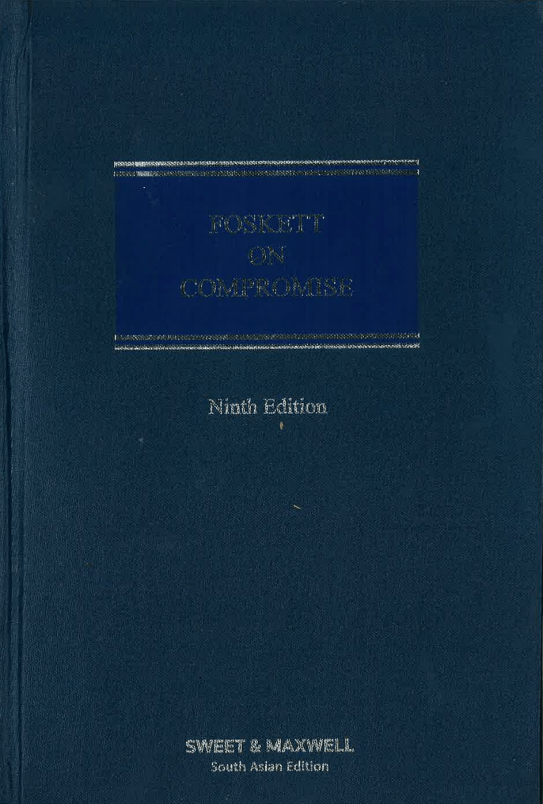Description
A compromise is the settlement of a dispute by mutual concession. Generally speaking a compromise occurs most often in a private law context, which is to say in disputes between individuals.
Under the Civil Procedure Rules, offers to settle have become one of the most important elements of the civil justice system; litigation should be viewed as the last resort. Part 36 of the CPR covers offers to settle and payments into court. Compromise can also result from arbitration or mediation.
The purpose of Foskett on Compromise is to provide practitioners with the necessary information to make use of the tools provided under the Rules. The book explains and provides authoritative guidance on the law of compromise and the various contexts in which it can be applied.
Features
- Provides authoritative guidance on the law of compromise.
- Establishes the legal foundations of compromise and the essential requirements of a valid compromise.
- Goes through the procedure of compromise, its machinery and methods, with particular attention to Part 36 of the CPR.
- Considers the consequences of a compromise and the effects of a breach.
- Examines the enforcement of a compromise and how a compromise is put into effect.
- Explains the practice of challenging the validity of (or ‘impeaching’) a compromise in order to have it set aside.
- Deals individually with different types of dispute, including: settlements in Chancery litigation; matrimonial, family and inheritance disputes; serious personal injury claims involving children or patients; employment contract disputes; landlord and tenant, boundary, and construction disputes.
- Includes analysis of compromise in arbitrations, appeals and ADR.
- Discusses the proper role of legal advisers (whether barrister, solicitor or other appropriate representative) in the process of compromise, including consideration of skills, responsibilities, obligations and liabilities.
- Covers insurance interests and compromise.
- Offers guidance and advice throughout as to best practice, for example as to what professional ethics and responsibility require in various situations.
- Contents:
- Part 1: The legal foundation and consequences of compromise;
- 1. Introduction;
- 2. Nature of a dispute;
- 3. Essential requirements of a valid Compromise;
- 4. Impeachment of a Compromise;
- 5. Terms of a Compromise;
- 6. Effects of a Compromise;
- 7. Satisfaction and Discharge of Obligations under a Compromise;
- 8. Effects of a Breach of a Compromise;
- Part 2: The machinery, practice and enforcement of a compromise;
- 9. Means by which Compromises are Effectuated;
- 10. Practice of Compromise;
- 11. Enforcement of a Compromise;
- Part 3: The practice on impeachment of a compromise;
- 12. Practice on Setting Aside a Compromise;
- Part 4: The settlement process in civil justice;
- 13. Present Landscape in Civil Litigation;
- 14. Structure of CPR Pt. 36;
- 15. The making, acceptance and consequences of an effective Part 36 Offer;
- 16. The court’s supervisory role in Part 36;
- 17. The effect of a Part 36 offer after trial;
- 18. Offers outside Part 36;
- 19. The “Without Prejudice” Rule;
- Part 5: Role of legal advisers in compromise;
- 20. Professional Ethics and Responsibilities;
- 21. Authority to Compromise and Liabilities of Legal Advisers Arising from Compromise;
- Part 6: Insurance interests and compromise;
- 22. Insurance Interests and Compromise;
- Part 7: Chancery litigation;
- 23. The Settlement of Chancery Litigation;
- Part 8: Matrimonial, family and inheritance disputes;
- 24. Compromise of Disputes between Husband and Wife and Civil Partners;
- 25. Settlement of Inheritance Act Disputes;
- 26. Offers of Settlement in Matrimonial Finance Cases;
- Part 9: The settlement of serious personal injury claims involving children or protected parties;
- 27. Settlement of Serious Personal Injury Claims Involving Children or Protected Parties;
- Part 10: Employment contracts and compromise;
- 28. Employment Contracts and Compromise;
- Part 11: Landlord and tenant and disputes over land;
- 29. Landlord and Tenant;
- 30. Disputes over land;
- Part 12: Construction litigation;
- 31. Construction disputes;
- Part 13: Arbitrations;
- 32. Settlement of Arbitrations;
- Part 14: Administrative court proceedings;
- 33. The Resolution by Agreement of Administrative Court Proceedings;
- Part 15: Appeals and ADR;
- 34. Settlement of Appeals;


Reviews
There are no reviews yet.